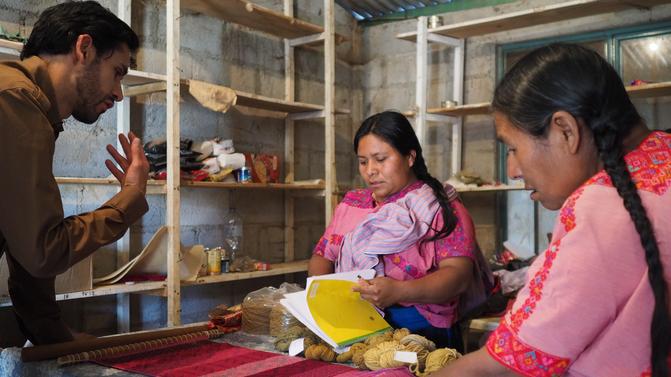Carlos Reyes and his collaboration with Mayan weavers
Carlos Reyes from Mexico City lived for a number of years in New York, where he became interested in cooperative art projects.
In his current art project, "Acciones de colaboración con grupos de tejedoras en México a través del teñido con tintes naturales y el uso de telar de cintura", he collaborates with local weavers from several of Mexico's states and in these videos he is in Chiapas.
He tells about his project and reflects on his experiences with the local weavers, where the collaboration has also been an encounter between two very different parts of Mexican culture: Carlos Reyes and his privileged middle-class background from the big city meeting with and the skillful weavers and their beautiful craftsmanship, but at times also from an economically disadvantaged life in the rural districts of Mexico.
We follow him to Magdalena, San Juan Chamula and Pantelhó in Chiapas and meet the local weavers.
Vídeo: Me enamoré de Chiapas
Log into your Vimeo account to see the video.
The artist Carlos Reyes is in Chiapas to collaborate with local weavers on his project with vegetable dyes.
Hear how he ended up in Chiapas and about the multiple purposes of the project.
Vocabulario al capítulo
- Sustantivos
artista m /f visual
Mercadotecnia f
Artes Plásticas m pl
proyecto m
arte m
tintes naturales
residencia de artista f
comunidad f
textil m
telar
artesano -
huipil m
coladera f
carrera f
colaboración f
objetivo
contaminación
Verbos
aceptar
contaminar
enseñar >< aprender
pasar
perder /ie -
regresar
teñir
tirar
usar
vender >< comprar
viajar
adjetivos y otros
a cambio
consciente
vario



Vegetable dye, Mayan designs and collaboration with local weavers
Carlos Reyes is in Chiapas to collaborate with local weavers on his project with vegetable dyes.
The starting point of the project is Leticia Arroyo's book Tintes naturales mexicanos, and he also draws inspiration from the work on Native Mexican designs in William Morris's book, Living Maya (Presencia Maya), where the designs and their symbolism, according to Morris, can be dated back to Mayan culture.
In the collaboration, stylized works are weaved by local weavers who each gets a single vegetable dye in a palette of shades to work with and together Carlos and the weaver decide which local design to use.
In the meeting with the skilled weavers, knowledge is exchanged both ways. The weavers use plants that grow in their area and not all the plants are reproduced in the book.
In turn, Carlos Reyes can contribute with knowledge of colour techniques and how to make colours more durable.

Más sobre...Casa Na Bolom


In San Cristóbal de las Casas lies the beautiful Casa Na Bolom. In addition to being a museum of Danish archaeologist Frans Blom and his Swiss wife Gertrudy Duby Blom's work with Lacandon Indians, the place serves as a hotel.
At the same time, artists and scientists working with indigenous cultures are offered shorter or longer stays in the student accommodation.
Casa Na Bolom in San Cristóbal de las Casas was founded in the fifties by the Danish arqueologist Frans Blom and the Schwiss photographer Gertrude Duby.
It serves a museum for the cultures of The Highlands of Chiapas and offers a very interesting library, a house of culture with exhibitions and concerts and a restaurant.
Furthermore the organisation supports various projects and releases, amongst others this edition on textiles by Walther F. Morris jr.:Guía textil de los Altos de Chiapas
See the webpage of the organisation: Casa Na Bolom
More about the organization and the founders: La asociación Na Bolom.
